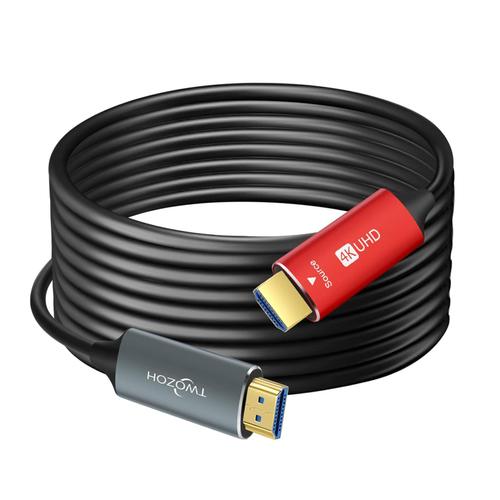By now, the HDMI format has been standardized to transmit audio and video on all types of devices. However, this does not mean that all High Definition Multimedia Interface cables are exactly the same and there are some that will get more use than others.
Today we are going to discover which HDMI cables are somewhat less known than the ones we all have at home and why they could be what you need to give a leap in quality to your image and sound on your Smart TV.
Fiber Optic HDMI Cable
The great improvement in HDMI cables has to do with the arrival of fiber optics, which we have already seen in network connectivity that provide a series of essential advantages today.
Under its most appropriate name, HDMI cable with fiber optic conductor, we have an evolution of the cables most used today for audio and video broadcasting that solves many of its problems. Thanks to the inclusion of fiber optics instead of much of the copper in standard cables, we have a very high data transmission speed, something that is necessary for higher resolutions and refresh rates (for example, 4K at 120Hz or more, or 8K resolution), especially for long distances since conventional cables begin to fail and lose quality from 10 meters away.

These cables have a characteristic difference from standard copper cables. The latter work bidirectionally, it does not matter which end goes to the source and which goes to the image and audio output. However, in fiber optic ones it does not matter which connector you connect to which device: the SOURCE end (source) must be connected to the sending device (for example, the game console), while the DISPLAY end (screen) must be connected to your TV or monitor.
Advantages of fiber in image and sound
The optical HDMI cable or AOC (active optical cable) is a hybrid cable, which combines optical fiber and copper cable. Fiber is responsible for transmitting the main content, video and audio. For its part, copper carries the auxiliary content: DDC signal, EDID, CEC and electricity.
One of the advantages of using this type of cables compared to pure copper cables is that the fiber is immune to interference, so it is much more recommended to avoid electrical contamination, poorly insulated ground loops, electromagnetic waves from WiFi. o Bluetooth and analog radio interference that is induced in poorly shielded cables.
Likewise, fiber does not corrode or oxidize, so it is more durable than copper. Of course, some extra care must be taken into account. Although these cables can be coiled without any problem, it is advisable not to bend the cable too much; Make sure it is at least 10 centimeters in diameter. Likewise, you should be a little more careful than usual when connecting it: never hold it by the cable or the rubber protrusion, always hold it by the hard part of the connector to prevent it from bending when connecting or disconnecting it.
Since fiber weighs less than copper, it takes up less space and the diameter of the cable is reduced. AOC HDMI cables are our great allies when we have to pass a cable through a very small space. Of course, if your devices (both the transmitter or source and the screen) are not compatible with the HDMI 2.0/2.1 standard, don’t even bother considering purchasing a fiber optic HDMI cable because it is not worth it, with a You will have more than enough HDMI cable for a lifetime.












